
Osage County is the largest county by area in the U.S. state of Oklahoma. Created in 1907 when Oklahoma was admitted as a state, the county is named for and is home to the federally recognized Osage Nation. The county is coextensive with the Osage Nation Reservation, established by treaty in the 19th century when the Osage relocated there from Kansas. The county seat is in Pawhuska, one of the first three towns established in the county. The total population of the county as of 2020 was 45,818.

Light Vessel Number 83 (LV-83) Swiftsure is a lightship and museum ship owned by Northwest Seaport in Seattle, Washington. Launched in 1904 at Camden, New Jersey and in active service until 1960 after serving on all five of the American west coast's lightship stations, it is the oldest surviving lightship in the United States, the only one still fitted with its original steam engine, and the last lightship with wooden decks. LV-83 was designated a National Historic Landmark in 1989, and has been undergoing major restoration since 2008.

Lagro Township is one of seven townships in Wabash County, Indiana, United States. As of the 2010 census, its population was 2,894 and it contained 1,214 housing units.
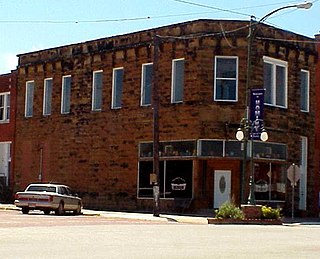
The Bank of Hominy, at W. Main St. and S. Price Ave. in Hominy, Oklahoma, is a building constructed in 1906, two years after the Oklahoma oil boom of 1904. It is one of four small bank buildings built in Richardsonian Romanesque style in Osage County, Oklahoma during 1904–1911. The others are Bank of Burbank, Bank of Bigheart, and Osage Bank of Fairfax.
The Bank of Burbank was a bank in Burbank, Oklahoma, and its historic bank building survives. The building was built in 1910. The bank operated through the Great Depression, and continued in business until 1948, when the bank ceased operating. The building was used for 30 years as the Burbank post office, and subsequently was renovated for use as a private residence. It was listed on the National Register of Historic Places in 1984.
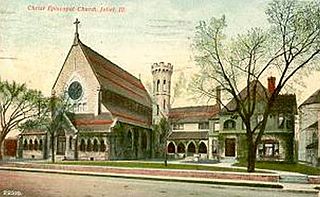
The Christ Episcopal Church was a historic building and former church in Joliet, Illinois.

The Quakertown Passenger and Freight Station is a historic train station and freight depot located at Quakertown, Bucks County, Pennsylvania. The two buildings were designed by Wilson Bros. & Company in 1889 and built by Cramp and Co. for the Philadelphia and Reading Railroad in 1902. The passenger station is constructed of dark Rockhill granite and Indiana limestone and is in a Late Victorian style. It is 1+1⁄2 stories tall and measures 25 feet wide by 97 feet 6 inches, long. It has a hipped roof with an eight-foot overhang. The freight station is a 1+1⁄2-story, rectangular stone block building measuring 128 by 30 feet. Also on the property is a large crane that was used for freight movement. The Quakertown station had passenger rail service along the Bethlehem Line to Bethlehem and Philadelphia until July 27, 1981, when SEPTA ended service on all its intercity diesel-powered lines. SEPTA still owns the line and leases it to the East Penn Railroad. Other towns, stations, and landmarks on the Bethlehem Line are Perkasie, Pennsylvania, Perkasie Tunnel, and Perkasie station.

The Bell Hill School or District Number One School is an historic school in Otisfield, Maine. The one-room brick schoolhouse was one of three completed in 1839 for the town, and is the only one to survive. It served the town as a district school until 1940. It was acquired in 1950 by the Bell Hill Meetinghouse Association, and has been converted into a local history museum. The building was listed on the National Register of Historic Places in 2003.

Salamonie River State Forest is a 850-acre (3.4 km2) state forest in Wabash and Huntington counties, Indiana.

The Ash Street School is a historic schoolhouse in Manchester, New Hampshire. It has been listed on the National Register of Historic Places since 1975. The school occupies the city block bounded by Ash, Bridge, Maple, and Pearl Streets.

Bennington No. 4, also known as the Bennington School, is a one-room schoolhouse near Waterloo, Iowa. Built in 1911, it served four sections which provided as many as thirty or more students for first through eighth grades. Students in higher grades attended Waterloo East High School. The school served the predominantly German-American community until 1955 when it was closed. While it was open, the school also served as a community center. In 1958 the vacant building was sold to the local Sage family, whose members had attended and taught at the school. Restoration work took place through the 1990s.

The St. Mark Church in St. Marks, Kansas, United States, is a historic Roman Catholic church building. It was built in c.1903-1906 and added to the National Register of Historic Places in 1991.
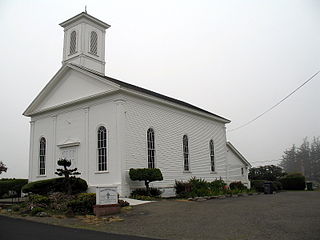
The Tomales Presbyterian Church and Cemetery is located at 11 Church Street in Tomales, California, United States. It was listed on the National Register of Historic Places in 1975.
The Amity School in Lincolnton, Georgia, United States is a historic school built during 1902–04. It was also used as a meeting hall. It was added to the National Register of Historic Places in 1993. It is located at Clay Hill Road west of the junction with GA 43.

The Osage Round House is a 16-sided structure used for Osage Ceremonial dances such as the Inlonska. It is the only such round house standing in Osage County, Oklahoma.
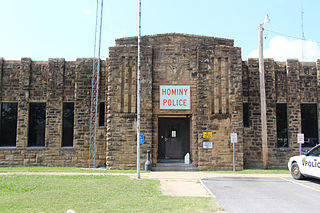
The Hominy Armory is a single story building measuring 257 feet x 141 feet. It was constructed between 1935 and 1937 by the Works Progress Administration. It originally housed the Hominy National Guard.

Hominy Ridge Shelter House is a historic park picnic shelter complex located in the Salamonie River State Forest, Lagro Township, Wabash County, Indiana. The shelterhouse was built in 1937 by the Civilian Conservation Corps, and is a rectangular Rustic style timber and stone structure with a five sided porch on each end. Associated with the shelter are 13 stone and timber picnic tables and the remains of a stone wall and an outhouse.
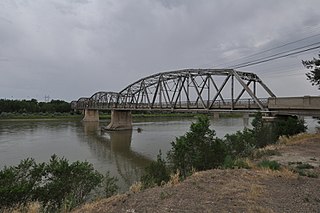
Completed in 1926 at a cost of $305,000, the Bell Street Bridge crosses the Yellowstone River in Glendive, Montana. Designed by the Montana Highway Commission and built by contractor Boomer, McGuire & Blakesley, the 1,352 feet (412 m) long, 20 feet (6.1 m) wide bridge consists of six Warren through truss spans, each roughly 219 feet (67 m) long, and a concrete approach span about 38 feet (12 m) long. It was listed on the National Register of Historic Places in 1988. At one time the main highway bridge over the river, Montana DOT rehabilitated and converted it for pedestrian use in 1992 when the bridge on the I-94 Business Loop was built 300’ to the north.

The Marland Filling Station at 102 South Wood in Hominy, Oklahoma was built in 1922. It was listed on the National Register of Historic Places in 2002.

The Fred and Adeline Drummond House is a home built in Hominy, Oklahoma in 1905 for Frederick Drummond and his wife Adeline Gentner. The home was given to the Oklahoma Historical Society in 1980 and added to the National Register of Historic Places in 1981. The listing included three contributing buildings, including the main house and a tiny home termed the "Moses House". The property is operated as a historic house museum by the Oklahoma Historical Society.


















